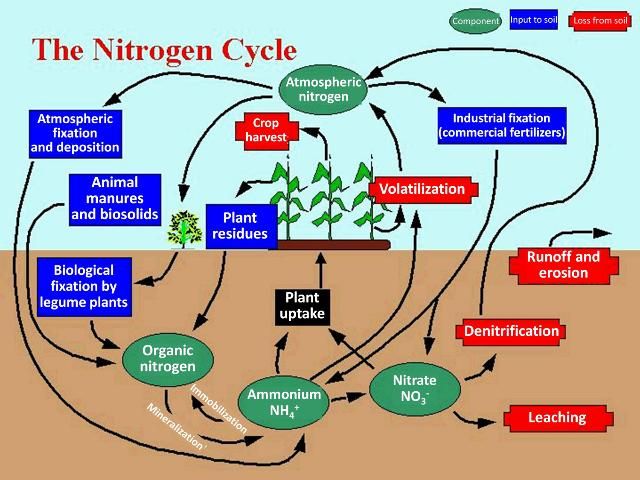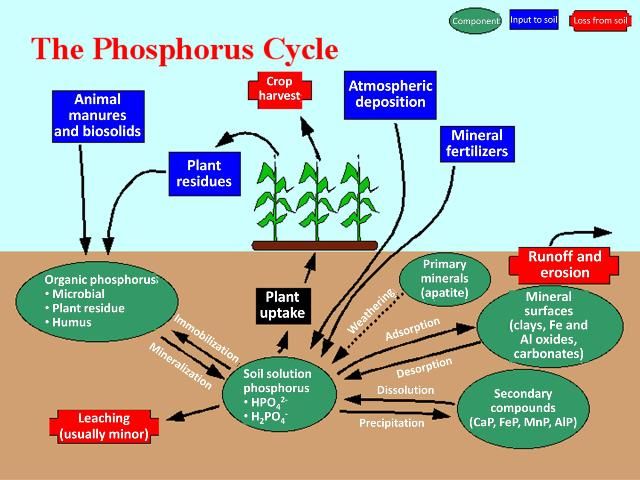Purpose
This publication provides an overview of nutrient (nitrogen and phosphorus) budgets for Extension educators, environmental management advisors, and governmental agency staff responsible for water quality. This document describes the types and limitations of nutrient budgets.
Introduction
Nitrogen (N) and phosphorus (P) losses from agricultural and urban non-point sources (those not easily traceable to a single source) have been linked to surface and ground water pollution. A water body may be designated as impaired when nutrients from agricultural and urban systems pollute water resources. When a water body is impaired, the water quality criteria are not met and the designated use of that water body (e.g., recreation, fishing, drinking water) may be compromised. Therefore, it is important to understand how nutrients move into, cycle within, and are transported out of urban or agricultural systems.
Nutrient inputs at a particular spatial scale or region should equal nutrient outputs at the same scale (or be as close to equal as possible). If not managed properly, nutrient inputs (usually from fertilizers or organic amendments) can lead to a nutrient surplus within a given area. When nutrient surpluses exist, the potential for non-point nutrient loss is increased. For example, N applied in excess of plant needs can be transported out of the system in runoff or leachate or can be lost to the atmosphere as ammonia gas (by volatilization). Phosphorus applied in excess of plant needs can build up in soils and potentially be lost during erosion or runoff events. In cases where the soil has a low P-holding capacity, P can also leach into groundwater during heavy precipitation or irrigation events. In addition, applying more nutrients than plants need can place an unnecessary economic burden on landowners.
Landowners can implement best management practices (BMPs) and nutrient management planning to reduce potential nutrient losses from agricultural and urban systems. In turn, these BMPs can help minimize economic and environmental costs. Nutrient budgeting is a management tool that can identify if nutrient inputs to and outputs from a specified area of interest are balanced (inputs = outputs), or if the area has a nutrient deficit (inputs < outputs) or surplus (inputs > outputs). Once the nutrient balance of a specified area is understood, BMPs can be implemented to manage nutrients in a way that minimizes losses that negatively impact the environment.
What is a nutrient budget?
A nutrient budget quantifies the amount of nutrients imported to and exported from a system (Table 1). The budget is considered in balance if inputs and outputs are equal. Nutrient budgets can be calculated at any scale, such as a farm, a county, a watershed, a state, or a country. The availability of data, as well as the scale of the unit of interest, will determine which nutrient balance approach is most appropriate.
Types of Nutrient Budgets
There are three main types of nutrient budgets: farm-gate, soil surface, and soil system.
A farm-gate nutrient budget only accounts for nutrient imports and exports relative to farm (or other similar unit) boundaries using data that can be collected easily at the unit level. These nutrient inputs and outputs (e.g., animal feed, fertilizers, crop, manure, and animal products) can be readily tracked. Hochmuth and Bennett (2011) present an example of a farm-gate budget in their publication available at https://edis.ifas.ufl.edu/ss547.
A soil surface nutrient budget accounts for all nutrients that enter the soil surface and leave the soil through crop uptake. In the case of N, the total amount of manure or fertilizer N applied would be adjusted to account for ammonia volatilization, since this N would not enter the soil surface. In addition, the soil surface budget includes estimates of nutrient inputs such as biological N-fixation and atmospheric deposition.
A soil system budget is the most comprehensive type of nutrient budget because all nutrient inputs and outputs in a given area of interest are included in the budget (Figures 1 and 2). The soil system budget requires the use of assumptions and estimations to account for nutrient transformations in the soil (e.g., immobilization, mineralization) and nutrient export from the system (e.g., losses through runoff, leaching, volatilization, and denitrification). Because a soil system budget relies on assumptions and estimates, more uncertainty is associated with this type of budget compared with farm-gate or soil surface budgets. The reliability of a soil system budget improves as more direct measurements of inputs, transformations, and losses are included.

Credit: IPNI

Credit: IPNI
Considerations when Developing Nutrient Budgets
Developing a sound nutrient budget requires accurate nutrient input, transformation (cycling), and output data. These data can come from actual measured parameters, previously published values, or data sets collected and compiled by various state or federal agencies. Budget components not readily described by available data are often estimated or generated using scientifically-based assumptions. The accuracy of nutrient budgets is limited by the estimations and assumptions used to generate data needed to calculate the budget. In any budgeting process, land managers should acknowledge that there are factors outside their control that can impact the fates of nutrient pools. For example, annual rainfall patterns can affect N balance from year to year. A nutrient surplus in a wet year may increase the potential for nutrient losses in runoff or leachate, while surpluses in a dry year may mean that less fertilizer needs to be applied during the next growing season.
Developing nutrient budgets at a small scale (farm) and large scale (state or national) is usually easy and straightforward because data are often readily available at these scales. In contrast, it is much more difficult to develop a nutrient budget at intermediate scales, especially at the watershed scale. Accurate data are often not available at the watershed scale because much of the statistical data used in the budget is collected according to geographic and municipal boundaries rather than watershed boundaries. In addition, farms and urban areas coexist within many watersheds, allowing nutrient flows from both systems to intermingle. Therefore, determining accurate nutrient budgets at smaller scales (farm, community) is important when making nutrient management decisions at the watershed scale. Accurately determining various budgets is important to encourage BMP adoption at the appropriate scale in the watershed.
Summary
A nutrient budget is a useful management tool that quantifies the amount of nutrients imported to and exported from a system. The goal of nutrient budgeting is to help landowners choose and implement BMPs that reduce the likelihood of nutrient surpluses, while maintaining or increasing agricultural production or urban aesthetics. Having a balanced nutrient budget for an agricultural or urban system helps avoid unnecessary production costs and greatly reduces pollution potential from surplus nutrients.
References
Hochmuth, G., and J. Bennett. 2011. Nutrient Mass Budget - The Case of Florida Watermelon Phosphorus Export. SL342. Gainesville: University of Florida Institute of Food and Agricultural Sciences. https://edis.ifas.ufl.edu/ss547
Oenema, O., H. Kros, and W. de Vries. 2003. "Approaches and Uncertainties in Nutrient Budgets: Implications for Nutrient Management and Environmental Policies." Eur. J. Agron. 20:3–16.
Watson, C. A., and D. Atkinson. 1999. "Using Nitrogen Budgets to Indicate Nitrogen Use Efficiency and Losses from Whole Farm Systems: A Comparison of Three Methodological Approaches." Nutr. Cycl. Agroecosyst. 53:259–67.